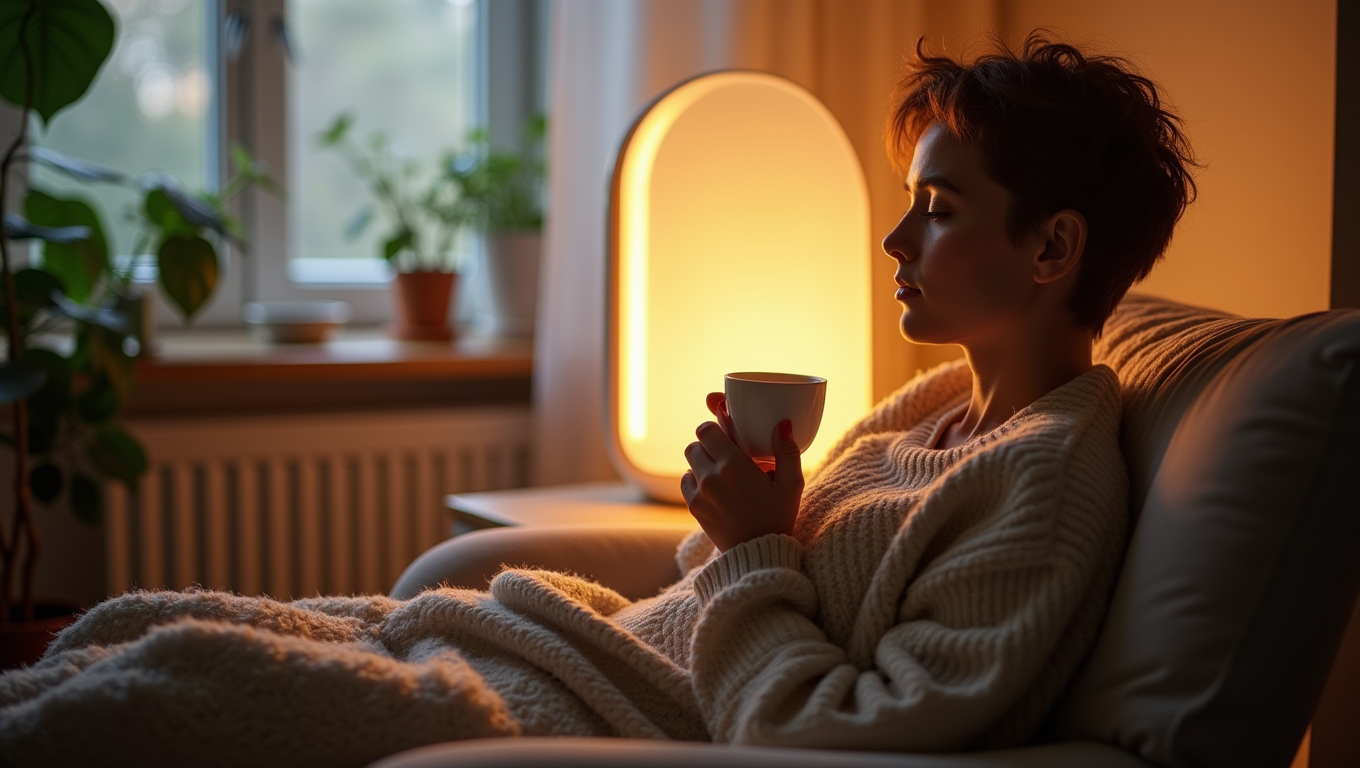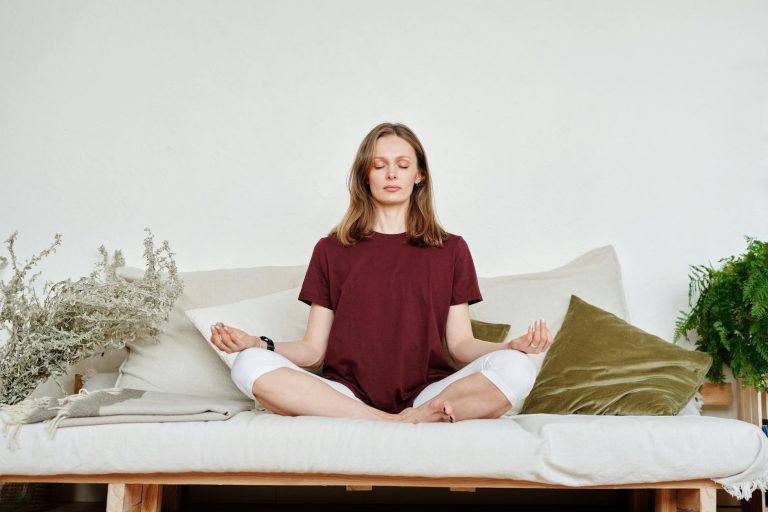Beat Seasonal Depression: Light Therapy and Mood-Boosting Habits
As the days grow shorter and darker, do you find yourself feeling inexplicably down? You’re not alone. Seasonal Affective Disorder (SAD), commonly known as seasonal depression, affects millions of people worldwide. 😔 But here’s the good news: you don’t have to suffer in silence or resign yourself to months of gloom.
Imagine waking up each morning, even on the darkest winter days, feeling refreshed and energized. Picture yourself sailing through your day with a positive outlook, regardless of the weather outside. This isn’t just a dream – it’s a reality that’s within your reach. 🌞 Light therapy, combined with mood-boosting habits, can be your secret weapon against the winter blues.
In this blog post, we’ll dive deep into the world of seasonal depression and explore powerful strategies to combat it. From understanding the basics of light therapy to discovering daily habits that can uplift your mood, we’ll equip you with a comprehensive toolkit to beat SAD. Get ready to shine a light on those dark winter days and reclaim your happiness!
Understanding Seasonal Depression
Recognizing the symptoms
Seasonal depression, also known as Seasonal Affective Disorder (SAD), manifests through various symptoms that can significantly impact an individual’s well-being. Common signs include:
- Persistent feelings of sadness or hopelessness
- Loss of interest in previously enjoyed activities
- Changes in sleep patterns (oversleeping or insomnia)
- Fatigue and low energy levels
- Difficulty concentrating or making decisions
- Changes in appetite and weight (often increased cravings for carbohydrates)
- Social withdrawal and isolation
It’s crucial to differentiate between occasional “winter blues” and SAD, which typically lasts for several months during specific seasons.
Identifying triggers
Several factors can trigger or exacerbate seasonal depression:
| Trigger | Description |
|---|---|
| Reduced sunlight | Disrupts circadian rhythms and serotonin production |
| Cold temperatures | May lead to decreased outdoor activities and social interaction |
| Holiday stress | Financial pressures and family obligations can worsen symptoms |
| Vitamin D deficiency | Common in winter months, affecting mood regulation |
Understanding these triggers can help individuals anticipate and manage their symptoms more effectively.
Impact on daily life
Seasonal depression can significantly affect various aspects of daily life:
- Work performance: Decreased productivity and difficulty meeting deadlines
- Relationships: Strained interactions with family, friends, and colleagues
- Physical health: Neglect of exercise and proper nutrition
- Self-care: Reduced motivation for personal hygiene and grooming
Recognizing these impacts is crucial for developing coping strategies and seeking appropriate support. With this understanding of seasonal depression, we can now explore the potential benefits of light therapy as an effective treatment option.
Light Therapy Basics
How light therapy works
Light therapy works by mimicking natural sunlight, which helps regulate our circadian rhythm and boost mood-enhancing neurotransmitters. When exposed to bright light, the retina sends signals to the brain, suppressing melatonin production and increasing serotonin levels. This process helps alleviate symptoms of seasonal depression by:
- Resetting the body’s internal clock
- Improving sleep patterns
- Enhancing energy levels
- Stabilizing mood
Types of light therapy devices
| Device Type | Description | Recommended Use |
|---|---|---|
| Light boxes | Tabletop devices emitting bright light | 20-30 minutes daily |
| Light visors | Wearable devices for hands-free therapy | 30-60 minutes daily |
| Dawn simulators | Alarm clocks that gradually increase light | Use upon waking |
| Full-spectrum lamps | Mimic natural daylight spectrum | Throughout the day |
Recommended usage and timing
For optimal results, follow these guidelines:
- Use light therapy within 1-2 hours of waking up
- Maintain a consistent daily routine
- Position the device 16-24 inches from your face
- Keep eyes open, but avoid looking directly at the light
- Start with 10-15 minutes, gradually increasing to 20-30 minutes
Potential side effects
While generally safe, some users may experience:
- Eyestrain or headaches
- Agitation or irritability
- Sleep disturbances if used late in the day
- Skin sensitivity in rare cases
To minimize risks, consult a healthcare professional before starting light therapy, especially if you have eye conditions or take photosensitizing medications. With proper use, light therapy can be an effective tool in managing seasonal depression symptoms.
Maximizing Light Therapy Benefits
Choosing the right light box
When selecting a light box for seasonal depression treatment, consider the following factors:
- Light intensity (measured in lux)
- Size and portability
- UV filtering
- Adjustable settings
A high-quality light box should provide 10,000 lux of light and have a large enough surface area to effectively deliver the light. Here’s a comparison of different light box types:
| Type | Intensity | Size | Portability | UV Filtering |
|---|---|---|---|---|
| Desk lamp | 10,000 lux | Medium | Moderate | Yes |
| Floor lamp | 10,000 lux | Large | Low | Yes |
| Travel light | 5,000-10,000 lux | Small | High | Yes |
Incorporating light therapy into your routine
To maximize the benefits of light therapy, follow these guidelines:
- Use the light box within the first hour of waking up
- Position the light box 16-24 inches from your face
- Use for 20-30 minutes daily
- Maintain a consistent schedule
Combining with other treatments
Light therapy can be more effective when combined with other treatments:
- Cognitive Behavioral Therapy (CBT)
- Regular exercise
- Vitamin D supplementation
- Healthy sleep habits
By integrating light therapy with these complementary approaches, you can significantly enhance its mood-boosting effects. Remember to consult with a healthcare professional before starting any new treatment regimen.
Now that we’ve covered how to maximize the benefits of light therapy, let’s explore additional mood-boosting habits that can complement your treatment plan.
Mood-Boosting Habits
Regular exercise routine
Regular exercise is a powerful tool in combating seasonal depression. A consistent workout routine can boost mood, increase energy levels, and improve overall well-being. Here’s a breakdown of effective exercise strategies:
| Exercise Type | Benefits | Recommended Frequency |
|---|---|---|
| Aerobic | Increases endorphins, improves cardiovascular health | 3-5 times per week |
| Strength | Builds muscle, boosts self-esteem | 2-3 times per week |
| Yoga | Reduces stress, improves flexibility | 2-4 times per week |
| Outdoor | Exposure to natural light, vitamin D synthesis | As often as possible |
To make exercise a habit, try these tips:
- Start small and gradually increase intensity
- Choose activities you enjoy
- Schedule workouts at consistent times
- Find an exercise buddy for accountability
Healthy sleep patterns
Maintaining a consistent sleep schedule is crucial for managing seasonal depression. Quality sleep helps regulate mood and energy levels. Consider the following strategies:
- Stick to a regular sleep-wake cycle, even on weekends
- Create a relaxing bedtime routine
- Limit screen time before bed
- Keep your bedroom cool, dark, and quiet
Nutritious diet choices
A balanced diet can significantly impact mood and energy levels. Focus on:
- Omega-3 fatty acids (found in fish, walnuts, and flaxseeds)
- Complex carbohydrates (whole grains, fruits, and vegetables)
- Lean proteins (poultry, legumes, and tofu)
- Vitamin D-rich foods (fortified dairy products, egg yolks)
Social connections
Maintaining strong social ties is essential for mental health. Engage in social activities by:
- Joining clubs or groups aligned with your interests
- Volunteering in your community
- Scheduling regular catch-ups with friends and family
- Participating in online communities if in-person meetings are challenging
Mindfulness and meditation
Practicing mindfulness and meditation can help manage stress and improve mood. Incorporate these techniques into your daily routine:
- Start with short, guided meditations
- Practice deep breathing exercises
- Try progressive muscle relaxation
- Use mindfulness apps for consistency and guidance
By incorporating these mood-boosting habits into your daily life, you can effectively complement light therapy in managing seasonal depression. Next, we’ll explore how to create a comprehensive action plan to tackle seasonal depression head-on.
Creating a Seasonal Depression Action Plan
Daily self-care checklist
Creating a daily self-care checklist is crucial for managing seasonal depression effectively. Here’s a sample checklist to help you stay on track:
- 30 minutes of light therapy
- 15 minutes of outdoor activity
- 3 healthy meals
- 8 hours of sleep
- 10 minutes of mindfulness or meditation
- 30 minutes of exercise
- Social interaction (in-person or virtual)
- Gratitude journaling
Customize this checklist to fit your needs and lifestyle, ensuring it’s realistic and achievable.
Tracking mood and progress
Monitoring your mood and progress is essential for understanding the effectiveness of your action plan. Use a simple mood tracking system:
| Day | Mood (1-10) | Notes |
|---|---|---|
| Mon | 7 | Felt energized after morning walk |
| Tue | 5 | Skipped light therapy, felt sluggish |
| Wed | 8 | Completed all checklist items |
Setting realistic goals
When setting goals to combat seasonal depression, remember the SMART criteria:
- Specific: Clearly define what you want to achieve
- Measurable: Quantify your progress
- Achievable: Ensure goals are within reach
- Relevant: Align goals with managing seasonal depression
- Time-bound: Set deadlines for accomplishment
Seeking professional help when needed
Recognize when it’s time to seek professional help. Warning signs include:
- Persistent low mood despite following your action plan
- Thoughts of self-harm or suicide
- Inability to perform daily tasks
- Significant changes in sleep or appetite
Don’t hesitate to reach out to a mental health professional for additional support and guidance. They can help adjust your action plan and provide specialized treatments if necessary.







